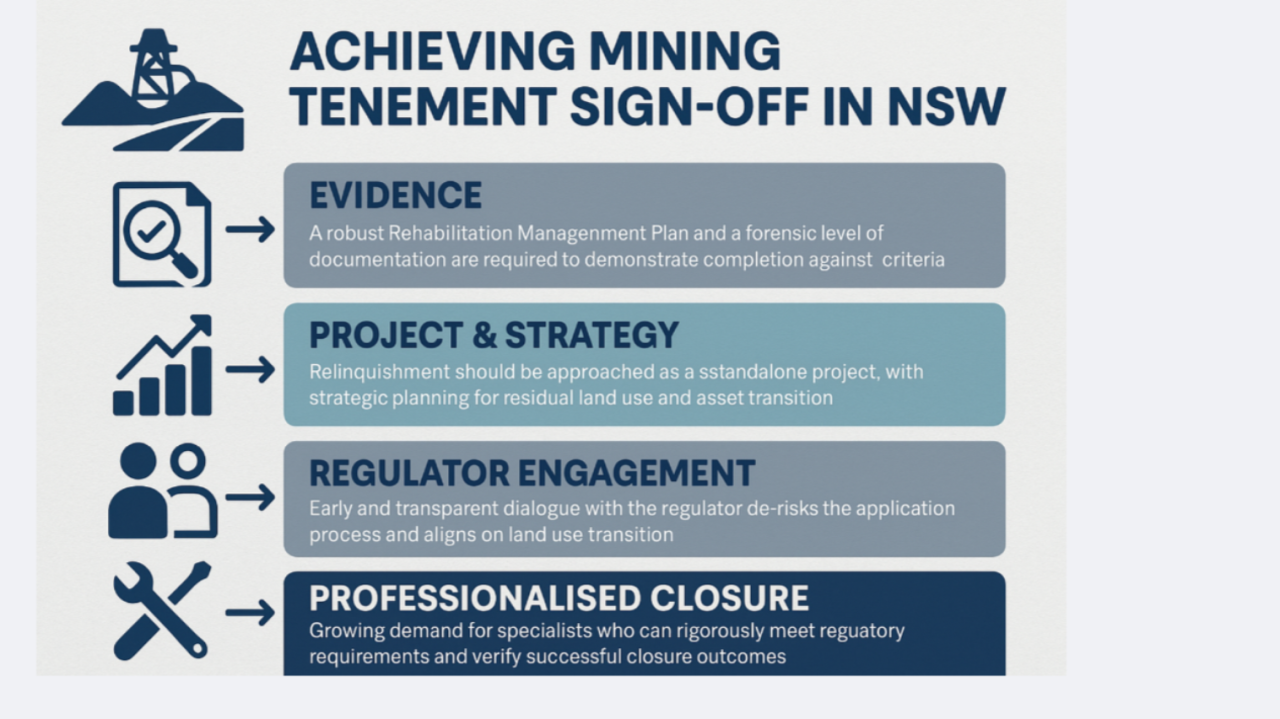By Andrew Hutton – Managing Director, IEMA
In the world of mining, extraction is only half the story. The other half – often less glamorous but just as critical – is what happens when the digging stops and how we can contemplate the transition of mine sites to a beneficial reuse that generates employment and supports the regional economies surrounding it.
Across New South Wales, a quiet transformation is underway. Mines are maturing, leases are winding down, and the industry is shifting from boom-and-bust to something more measured: legacy management, rehabilitation, and ultimately, relinquishment.
But if you’ve ever tried navigating the maze of mining lease sign-off in NSW, you’ll know it’s not just a matter of ticking boxes and walking away. Nor should it be.
The Missing Piece? Evidence
At the heart of the process is evidence, not intent, not effort, but cold, hard proof squarely based on a firm base of a solid and robust risk assessment.
In our experience, the NSW Resources Regulator wants to see that every risk has been controlled, every contour restored, and every patch of land returned to a safe, stable, and sustainable state. That means having a robust Rehabilitation Management Plan, documented works, and a rigorous level of verification.
This is where Inspection and Test Plans (ITPs) come into their own. Too often treated as back-office admin, they’re actually the backbone of the entire process. ITPs show how each rehabilitation activity was executed, assessed, and verified. They create the traceability regulators need to say “yes.”
Without structured, consistent records management, it’s impossible to demonstrate compliance confidently. Strong projects are now building their Relinquishment Assurance Reports (RARs) off carefully curated evidence chains supported by ITP completion data—not guesswork.
It’s Also Intelligent Use of Spatial Tech
Gone are the days when relinquishment was tracked in folders and memory sticks. Today, spatial data systems are driving decision-making, visualising what areas are ready for submission, overlaying verification data, and identifying gaps.
Smart operators are using GIS platforms to:
- Map completion criteria against real-time landform data
- Identify high-risk zones like tailings facilities
- Track forward works with geospatial accuracy
- Collect evidence spatially
- Use AI to generate workflows and match site obligations
This spatial intelligence isn’t just a visual tool – it’s a strategic asset. It helps teams prioritise work, engage with regulators using evidence, and communicate progress with stakeholders.
It’s a Project and a Strategy
Too often, companies treat relinquishment as the final checkbox on a closure plan. In reality, it’s a standalone project – with its own scope, resources, and risks. It’s big, the dollars are material – treat it like it’s a $50M project, not a rehab job. Establish governance, processes and IPRs. Move along the project pathway of Concept, PFS and Feasibility – and give yourself plenty of time to pivot whilst you have budget, cashflow, kit and people on site.
The most forward-thinking operators are treating relinquishment as a strategic opportunity. They’re using spatial analysis to map areas for early sign-off and getting them through the process ahead of time. Using the processes to build credibility with stakeholders is key. They’re integrating post-mining land use into their plans. They’re even lining up rezoning applications and new approvals alongside ESF2 submissions to unlock future land value and direct the relinquishment of the site towards a known beneficial reuse – which narrows the breadth of “what ifs” and options.
It’s about transitioning an asset, not just closing a liability.
Regulator Engagement Matters
One of the most underappreciated aspects of the process? Genuine Dialogue.
The best outcomes come when operators engage early and transparently with the regulator – presenting draft RARs, discussing land use transitions, and clarifying long-term residual risk management strategies.
These conversations aren’t about box-ticking—they’re about building alignment. When done well, they remove ambiguity, build confidence, and streamline the ESF2 process.
The Future of Mine Closure Is Professionalised
We’re entering an era where closure and relinquishment are treated with the same rigor as development and operations. It’s now a specialty and it requires project managers who can move across all technical issues and challenges. Subject Matter Experts (SMEs) are essential, but it’s much more than designing a cap, reviewing a landform, modelling water, or engaging with community—it’s about meshing it all together and managing risk.
That means:
- Project-managed relinquishment pathways
- Project governance and processes
- Detailed and dynamic risk assessments
- Dedicated specialists in spatial, rehab, risk, and land use
- Robust ITPs and digital evidence systems
- Transparent reporting and regulator engagement
It’s no longer enough to “rehab and hope.” Companies need to verify and validate – and they need to prove it with systems that hold up under scrutiny.
As more NSW operators edge closer to end-of-mine life, the conversation is shifting from “how do we comply?” to “how do we exit well?”
That’s not just a compliance challenge – it’s a reputational and strategic opportunity. And for those who get it right, relinquishment doesn’t mark the end, nor does it need to be made hard and drag on. Holding costs for mining leases are material, and care and maintenance does not mean no costs. It marks the handover to what comes next, whether that’s conservation, community benefit, or commercial redevelopment.
